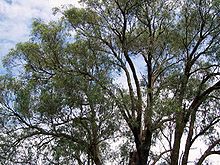
Eucalyptus dives, commonly known as the broad-leaved peppermint or blue peppermint, is a species of tree that is endemic to south-eastern Australia. It has rough, finely fibrous bark on the trunk and larger branches, smooth bark above, lance-shaped or curved adult leaves, flower buds in groups of eleven or more, white flowers and cup-shaped, hemispherical or conical fruit.
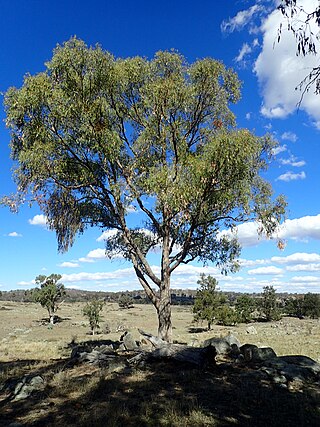
Eucalyptus nova-anglica, commonly known as the New England peppermint or black peppermint, is a species of small to medium-sized tree endemic to eastern Australia. It has thick, rough, fibrous bark on the trunk and larger branches, lance-shaped adult leaves, flower buds in groups of seven, white flowers and hemispherical or conical fruit.
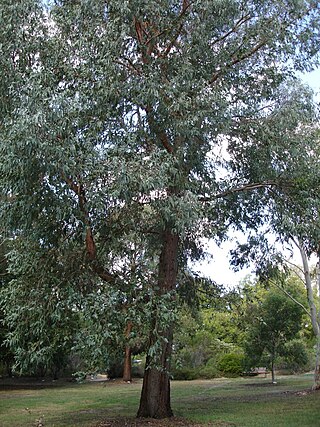
Eucalyptus chapmaniana, commonly known as the Bogong gum, is a species of small to medium-sized tree endemic to montane and eastern Australia. It has rough, fibrous and fissured bark on most of the trunk and smooth light brown to grey bark often shed in long ribbons on the branches. The adult leaves are lance-shaped to curved, the flower buds in groups of three and the fruit a conical or bell-shaped capsule.

Eucalyptus rubida, commonly known as candlebark, ribbon gum or white gum, is a species of small to medium-sized tree that is endemic to south-eastern Australia. It has smooth bark, sometimes with rough bark at the base, lance-shaped or curved adult leaves, flower buds in groups of three, white flowers and cup-shaped, hemispherical or bell-shaped fruit.
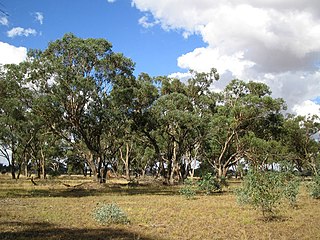
Eucalyptus microcarpa, commonly known as grey box, is a species of tree that is endemic to southeastern continental Australia. It has rough, fibrous or flaky bark on the trunk, smooth whitish bark above, lance-shaped adult leaves, flower buds in groups of between seven and eleven, white flowers and oval, cylindrical or urn-shaped fruit.

Eucalyptus woollsiana is a species of tree that is endemic to eastern Australia. It has rough, fibrous bark on the trunk, smooth bark above, lance-shaped adult leaves, flower buds in groups of five or seven, white flowers and cup-shaped fruit.
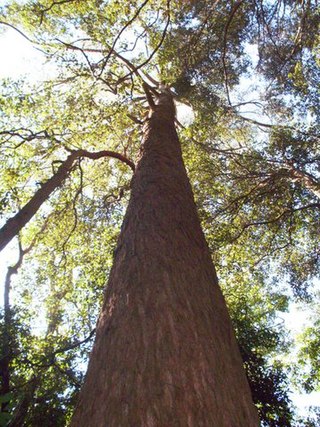
Eucalyptus fastigata, commonly known as brown barrel or cut-tail, is a species of medium-sized to tall tree that is endemic to southeastern Australia. It has fibrous or stringy bark on the trunk and larger branches, smooth bark above, lance-shaped to curved adult leaves, flower buds in groups of eleven or more, white flowers and conical or pair-shaped fruit.
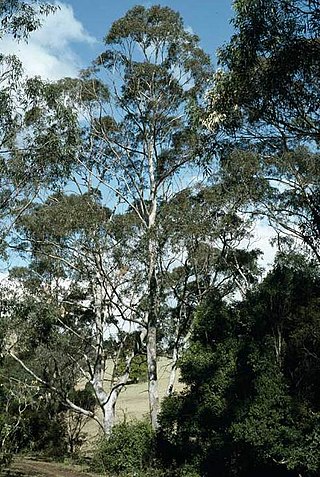
Eucalyptus quadrangulata, commonly known as the white-topped box or coast white box, is a species of small to medium-sized tree that is endemic to eastern Australia. It has rough, fibrous or flaky bark on the trunk and branches, lance-shaped to curved adult leaves, flower buds in groups of seven, white flowers and conical fruit.

Eucalyptus parvula, commonly known as small-leaved gum, is a species of small tree that is endemic to south-eastern New South Wales. It has mostly smooth bark, elliptical to lance-shaped adult leaves but with many juvenile of intermediate leaves in the crown, flower buds in groups of seven, white flowers and cup-shaped fruit.

Eucalyptus kartzoffiana, commonly known as the Araluen gum, is a species of medium-sized tree that is endemic to a small area of southeastern New South Wales. It has rough, fibrous or flaky bark on part or most of its trunk, lance-shaped or curved adult leaves, flower buds in groups of three, white flowers and sessile, bell-shaped fruit.

Eucalyptus consideniana, commonly known as yertchuk, is a species of plant in the myrtle family and is endemic to south-eastern Australia. It is a tree with rough, fibrous, sometimes prickly bark on the trunk and larger branches, smooth grey bark above, lance-shaped or curved adult leaves, flower buds in groups of between eleven and nineteen, white flowers and conical to hemispherical fruit.

Eucalyptus banksii, commonly known as the Tenterfield woollybutt, is a tree that is endemic to eastern Australia. It has rough fibrous or flaky bark, lance-shaped to curved leaves, flower buds without a pedicel in groups of seven in leaf axils, white flowers and hemispherical to cup-shaped or conical fruit.
Eucalyptus ignorabilis is a species of small to medium-sized tree that is endemic to southeastern Australia. It has rough, fibrous bark on the trunk and branches, lance-shaped to curved adult leaves, flower buds in groups of seven, white flowers and cup-shaped to hemispherical fruit. It is found in far southeastern New South Wales and eastern Victoria.

Eucalyptus intertexta, commonly known as inland red box, western red box, gum coolibah or the bastard coolibah, is a species of tree that is endemic to central Australia. It has rough, fibrous or flaky bark on the base of the trunk, smooth white to brownish bark above, lance-shaped adult leaves, flower buds in groups of seven on the ends of branchlets, white flowers and cup-shaped to hemispherical fruit.

Eucalyptus magnificata, commonly known as blue box or northern blue box, is a species of small tree or sometimes a mallee that is restricted to a small area of New South Wales. It has rough, fibrous or flaky bark on the trunk and larger branches, smooth bark above, broadly lance-shaped to egg-shaped leaves, flower buds in groups of seven, white or pale yellow flowers and conical fruit.
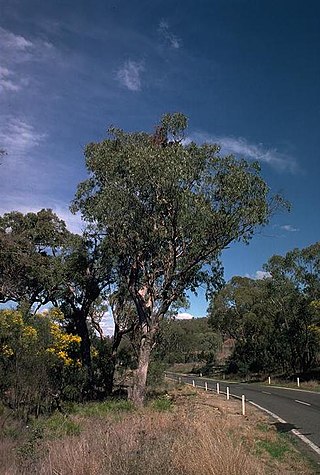
Eucalyptus malacoxylon, commonly known as Moonbi apple box or apple box, is a species of small to medium-sized tree that is endemic to a restricted area of New South Wales. It has rough, fibrous or flaky bark on the trunk and larger branches, smooth bark on the thinnest branches, lance-shaped adult leaves, flower buds in groups of seven, white flowers and cup-shaped, conical or hemispherical fruit.

Eucalyptus mckieana, commonly known as McKie's stringybark, is a species of tree that is endemic to New South Wales. It has rough, stringy bark on the trunk and branches, lance-shaped to curved adult leaves, flower buds in groups of between seven and eleven, white flowers and cup-shaped, barrel-shaped or hemispherical fruit.
Eucalyptus obconica is a species of small tree or a mallee the is endemic to the Kimberley region of Western Australia. It has rough fibrous or flaky, wavy bark on the trunk and branches, lance-shaped to curved or oblong adult leaves, flower buds in groups of seven, white flowers and conical fruit.

Eucalyptus conglomerata, commonly known as the swamp stringybark, is a species of straggly tree or mallee that is endemic to Queensland. It has rough, fibrous "stringybark" lance-shaped to oblong adult leaves, flower buds in groups of eleven or more, white flowers and more or less barrel-shaped fruit.

Eucalyptus microneura, commonly known as Gilbert River box, is a species of small to medium-sized tree that is endemic to Queensland. It has rough, fibrous or flaky bark on the trunk and branches, lance-shaped adult leaves, flowers in groups of seven on a branching peduncle, white flowers and conical fruit.
